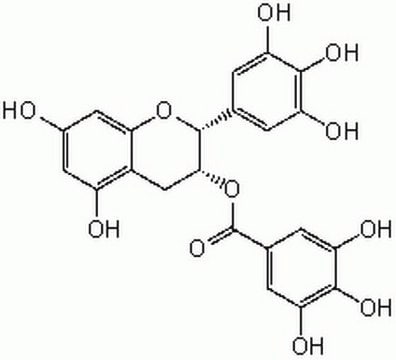E4268
(−)-Epigallocatechin gallate
≥80% (HPLC), from green tea
Synonyme(s) :
(−)-cis-2-(3,4,5-Trihydroxyphényl)-3,4-dihydro-1(2H)-benzopyrane-3,5,7-triol 3-gallate
About This Item
Produits recommandés
Source biologique
green tea
Pureté
≥80% (HPLC)
Application(s)
metabolomics
vitamins, nutraceuticals, and natural products
Température de stockage
2-8°C
Chaîne SMILES
Oc1cc(O)c2C[C@@H](OC(=O)c3cc(O)c(O)c(O)c3)[C@H](Oc2c1)c4cc(O)c(O)c(O)c4
InChI
1S/C22H18O11/c23-10-5-12(24)11-7-18(33-22(31)9-3-15(27)20(30)16(28)4-9)21(32-17(11)6-10)8-1-13(25)19(29)14(26)2-8/h1-6,18,21,23-30H,7H2/t18-,21-/m1/s1
Clé InChI
WMBWREPUVVBILR-WIYYLYMNSA-N
Informations sur le gène
human ... CYP1A2(1544)
Vous recherchez des produits similaires ? Visite Guide de comparaison des produits
Description générale
Application
- a potential neuroprotective agent to test its protective effect against spinal cord injury and blood-spinal cord barrier (BSCB) leakage
- an effective antioxidant against light-induced photoreceptor degeneration in mice retina
- an antioxidant in retinitis pigmentosa (RP) and reduces oxidative damage and changes circadian rhythms in pigmented heterozygous P23H rat
- to test its reversal effect on Diastolic dysfunction in restrictive cardiomyopathy (RCM) mice
- an anti-cancer agent in colorectal cancer in mice
Actions biochimiques/physiologiques
Mention d'avertissement
Warning
Mentions de danger
Conseils de prudence
Classification des risques
Acute Tox. 4 Oral - Aquatic Chronic 2 - Eye Irrit. 2 - Skin Sens. 1
Code de la classe de stockage
11 - Combustible Solids
Classe de danger pour l'eau (WGK)
WGK 2
Point d'éclair (°F)
Not applicable
Point d'éclair (°C)
Not applicable
Équipement de protection individuelle
Eyeshields, Gloves, type N95 (US)
Certificats d'analyse (COA)
Recherchez un Certificats d'analyse (COA) en saisissant le numéro de lot du produit. Les numéros de lot figurent sur l'étiquette du produit après les mots "Lot" ou "Batch".
Déjà en possession de ce produit ?
Retrouvez la documentation relative aux produits que vous avez récemment achetés dans la Bibliothèque de documents.
Les clients ont également consulté
Articles
Antioxidants protect biological systems from oxidative damage produced by oxygen-containing free radicals and from redoxactive transition metal ions such as iron, copper, and cadmium.
Notre équipe de scientifiques dispose d'une expérience dans tous les secteurs de la recherche, notamment en sciences de la vie, science des matériaux, synthèse chimique, chromatographie, analyse et dans de nombreux autres domaines..
Contacter notre Service technique










